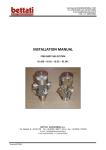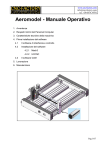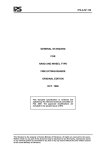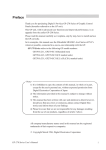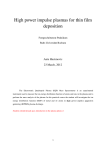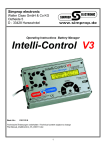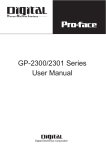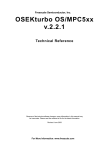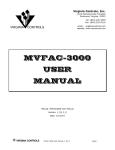Download INSTALLATION MANUAL - Bettati Antincendio
Transcript
Via Disraeli, 8 42124 REGGIO EMILIA ‐ ITALY Tel. +39 0522 369711 Fax +39 0522 791052 E‐mail: [email protected] P.IVA – C.F. 01979170352 INSTALLATION MANUAL FOR HALOCARBON GAS SYSTEM HFC 227EA – HFC 125 – HFC 23 BETTATI ANTINCENDIO s.r.l. Via Disraeli, 8 ‐ 42124 RE Tel. +39 0522 / 369711 (R.A.) ‐ fax +39 0522 / 791052 E‐mail: [email protected] P.IVA 01979170352 C.F. 01979170352 Revised 05/2010 1 1 Via Disraeli, 8 42124 REGGIO EMILIA ‐ ITALY Tel. +39 0522 369711 Fax +39 0522 791052 E‐mail: [email protected] P.IVA – C.F. 01979170352 Revised 05/2010 2 Via Disraeli, 8 42124 REGGIO EMILIA ‐ ITALY Tel. +39 0522 369711 Fax +39 0522 791052 E‐mail: [email protected] P.IVA – C.F. 01979170352 Contents 1 Introduction ...............................................................................................................................................4 1.1 General information .....................................................................................................................................4 1.2 Scope and purpose of manual ......................................................................................................................6 1.3 Standards and Code of practice....................................................................................................................6 1.4 Transport and material management...........................................................................................................7 1.5 Preliminary control and operations..............................................................................................................9 2 System description ................................................................................................................................... 10 2.1 Single cylinder system ................................................................................................................................10 2.2 Multiple cylinders system...........................................................................................................................11 2.3 Components description ............................................................................................................................12 2.3.1 Cylinder ..................................................................................................................................................12 2.3.2 Discharge valve ......................................................................................................................................13 2.3.3 Solenoid actuator...................................................................................................................................15 2.3.4 Removable pressure gauge with supervisory pressured switch............................................................16 2.3.5 Pilot flex hose.........................................................................................................................................17 2.3.6 Discharge flex hose ................................................................................................................................18 2.3.7 Check valve ............................................................................................................................................19 2.3.8 Discharge manifold ................................................................................................................................19 2.3.9 Pipe line pressure switch .......................................................................................................................20 3 Mechanical and electrical installation ...................................................................................................... 23 3.1 Procedure of installation ...........................................................................................................................23 3.2 Cylinders installation ..................................................................................................................................26 3.2.1 General consideration for cylinder installation .....................................................................................26 3.2.2 SINGLE cylinder installation ...................................................................................................................28 3.2.3 SINGLE‐ROW multiple cylinders installation..........................................................................................30 3.3 Discharge flex hose installation ..................................................................................................................31 3.4 Discharge manifold installation ..................................................................................................................32 3.4.1 Discharge manifold placement for multiple cylinders system...............................................................33 3.5 Removable pressure gauge with supervisory pressured switch assembly installation ..............................35 3.6 Electrical/manual solenoid actuator installation and pneumatic connection............................................36 3.7 Pilot pneumatic connection........................................................................................................................38 3.7.1 Single cylinder........................................................................................................................................38 3.7.2 Pilot and slave Cylinder..........................................................................................................................39 4 Pipes, fittings, brackets and nozzles installation........................................................................................ 40 5 Mechanical system acceptance................................................................................................................. 40 5.1 Testing procedures .....................................................................................................................................40 5.1.1 Protected area volume ..........................................................................................................................42 5.1.2 Protected area integrity........................................................................................................................42 5.1.3 Design correspondence .........................................................................................................................43 5.1.4 Pipeline fixing.........................................................................................................................................43 5.1.5 Pipeline locking ......................................................................................................................................43 5.1.6 Pneumatic circuit ...................................................................................................................................43 5.1.7 Functional Test.......................................................................................................................................45 6 Extinguishing system start up ................................................................................................................... 48 6.1 Electrical‐Mechanical connection Solenoid Actuator.................................................................................48 Revised 05/2010 3 Via Disraeli, 8 42124 REGGIO EMILIA ‐ ITALY Tel. +39 0522 369711 Fax +39 0522 791052 E‐mail: [email protected] P.IVA – C.F. 01979170352 1 Introduction 1.1 General information These systems, described in this manual, use the halocarbon chemical agent and consist of two basic components. The basic components used for these system are: Storage/Distribution components; Detection and alarm devices and control panels. Storage/Distribution components Table 1.1 List of components 1 2 3 4 5 Standard Ref. List of components EN 12094‐8 EN 12094‐13 PED 97/36/CE EN 12094‐4 TPED 99/36/CE Connectors Non‐return Valve and check Valve Discharge Manifold Discharge Valve and its actuator Cylinder Removable pressure gauge with supervisory pressured switch and pressure switch Nozzle 6 EN 12094:10 7 /// 7 Fig.1.1 List of mechanical components Revised 05/2010 4 Via Disraeli, 8 42124 REGGIO EMILIA ‐ ITALY Tel. +39 0522 369711 Fax +39 0522 791052 E‐mail: [email protected] P.IVA – C.F. 01979170352 Detection and alarm devices and control panel Smoke and Heat Detectors Manual release point EN 12094-3 EN 54-11 Manual Emergency stop EN 12094-3 En 54-11 Manual call point EN 54-11 Pressure Gauge and Pressure Switch EN 12094-10 Conventional fire-fighting extinguishing Panel EN 12094-1 Pre-Alarm Alarm Fault Pressure Gauge and Remotaggio Allarme Solenoid actuator EN 12094-4 Acoustic siren EN 54-3 Audio-Visual Panel EN 54-3 Fig.1.2 List of components of the detection system Revised 05/2010 5 Via Disraeli, 8 42124 REGGIO EMILIA ‐ ITALY Tel. +39 0522 369711 Fax +39 0522 791052 E‐mail: [email protected] P.IVA – C.F. 01979170352 1.2 Scope and purpose of manual This manual is a comprehensive guide containing all recommendations necessary to install the Halocarbon HFC125, HFC227EA and HFC23 Gas Extinguishing Systems supplied by Bettati Antincendio srl. Discharge of a unsecured and disconnected cylinder could be extremely dangerous and may result in injury or death, and/or damage the property. NEVER connect the pilot or slave discharge head, solenoid pilot valve assembly or flexible pilot connectors to the cylinders, or have the solenoid pilot valve wired to the system’s electrical control UNTIL the cylinder has been properly secured in the cylinder rack and the discharge connection fittings connected to the system piping. High‐pressure‐stored gasses are involved in the installation of this system The installation of the system must be complying with the requirement of this manual The installation shall be done ONLY by recommended Bettati Antincendio trained technician 1.3 Standards and Code of practice Systems that use extinguishing Halocarbon HFC125, HFC227EA and HFC23 agents are designed according to these standards: EN 15004‐1:2008 “Fixed firefighting systems. Gas extinguishing systems. Part 1: Design, installation and maintenance”. EN 15004‐4:2008 “Fixed firefighting systems. Gas extinguishing systems. Part 4: Physical Properties And System Design Of Gas Extinguishing Systems For HFC 125 Extinguishant”. EN 15004‐5:2008 “Fixed firefighting systems. Gas extinguishing systems Part 5: Physical properties and system design of gas extinguishing systems for HFC 227ea extinguishant”. EN 15004‐6:2008 “Fixed firefighting systems. Gas extinguishing systems ‐ Part 6: Physical properties and system design of gas extinguishing systems for HFC 23 extinguishant”. Components used in the system that use extinguishing Halocarbon HFC125, HFC227EA and HFC23 agents meet the requirements of the following standards: EN 12094‐4:2004 “Fixed firefighting systems. Components for gas extinguishing systems. Requirements and test methods for container valve assemblies and their actuators”. EN 12094‐5:2004 “Fixed firefighting systems. Components for gas extinguishing systems. Requirements and test methods for high and low pressure selector valves and their actuators”. EN 12094‐6:2006 “Fixed firefighting systems. Components for gas extinguishing systems. Requirements and test methods for non‐electrical disable devices”. EN 12094‐8:2006 “Fixed firefighting systems. Components for gas extinguishing systems. Requirements and test methods for flexible connectors”. EN 12094‐10:2004 “Fixed firefighting systems ‐ Components for gas extinguishing systems. Requirements and test methods for pressure gauges and pressure switches” EN 12094‐13:2002 “Fixed firefighting systems. Components for gas extinguishing systems. Requirements and test methods for check valves and non‐return valves”. Revised 05/2010 6 Via Disraeli, 8 42124 REGGIO EMILIA ‐ ITALY Tel. +39 0522 369711 Fax +39 0522 791052 E‐mail: [email protected] P.IVA – C.F. 01979170352 1.4 Transport and material management For the gas extinguishing cylinder transport it must be used proper means of transport and it must be consulted the MSDS (Material Safety Data Sheet) attached with the technical file. The cylinder must: • remain either in the pallets or in the proper containers until the ground placement, Fig.1.3a Cylinders located on pallets • Fig.1.3b Cylinders placed in a container be managed by skilled worker and with proper means, NO YES Fig.1.4 Trailer truck to carry cylinders During the cylinders handling the valve cap must be correctly placed on the top of the cylinder • • • • be placed in a clean and dry place, be stored in a sheltered place, protected from heat and atmospheric agents, avoid aisles and other high traffic areas where physical damage or tampering is more likely. Containers should never be mounted where the container could potentially be splashed with, or submerged in any liquid, cylinder valve cap and all the safety plugs for the pressure connection must be in place when the cylinders are moved or transported, Revised 05/2010 7 Via Disraeli, 8 42124 REGGIO EMILIA ‐ ITALY Tel. +39 0522 369711 Fax +39 0522 791052 E‐mail: [email protected] P.IVA – C.F. 01979170352 • Ensure the correct installation position of every cylinder, as shown in the technical drawing. Every cylinder is provided with specific labels that: provides the specific information (contained gas, serial number, operating pressure, weight information: tare, gross and agent); shows the valve outlet position (this label is useful for the placement of the cylinder, as the valve outlet is hidden by cylinder cap); describes the safety information for the handling and storage; describes the transport data. Safety label Transports tag Cylinder label Valve outlet label Fig.1.6 Cylider’s tags and labels Revised 05/2010 8 Via Disraeli, 8 42124 REGGIO EMILIA ‐ ITALY Tel. +39 0522 369711 Fax +39 0522 791052 E‐mail: [email protected] P.IVA – C.F. 01979170352 1.5 Preliminary control and operations Check that the cylinders support base (especially in case of floor or underfloor voids placement) and the entire structure can support the total loads shown in the following tables (table 1.2); Make a visual checking of the material, ensuring that the quantity of the items match the quantity reported on the data sheet and that it has got the technical specifications reported on the manual “Engineered System”; All the other materials must be stored in a shelter place, protected from the atmospheric agents, in order to prevent any damage. The cylinder valve cap can be removed ONLY after the installation of the cylinders. In order to avoid accidental discharge, the connection between pilot flex hose and the solenoid actuator (see figure 2.1 in the next paragraph, components n° 6 and n° 13) must be done ONLY after the test. The cylinders and the accompanying hardware will be supplied with the necessary accessory in according with Bettati Antincendio standard. The cylinder installation shall be wall‐mounted; in order to do so a suitable place must be found. The brackets and the rawlplugs used for the installation must support the total load. Normally the cylinder should be placed in a dry and well‐ventilated place in order to avoid corrosion and usury phenomena. Execute the following control procedure, in case of not correspondence with the original design, inform Bettati Antincendio before the installation beginning. Capacity (L) 14 27 50 75 External diameter (mm) Length (mm) Weight (Kg) 168 800 17 203 1020 25 269 1080 46 360 1030 65 15203 613 3523 120 3604 14704 1194 180 406 1780 175 1,2 200 400 1570 /// 1. Certification in progress 2. Welded cylinder, work pressure 42 bar, test pressure 90 bar 3. only for HFC227ea – HFC125 4. only for HFC23 Table.1.2 Dimensions and weights of the cylinders Revised 05/2010 9 9 Via Disraeli, 8 42124 REGGIO EMILIA ‐ ITALY Tel. +39 0522 369711 Fax +39 0522 791052 E‐mail: [email protected] P.IVA – C.F. 01979170352 2 System description The fire‐fighting gas extinguishing system HFC227ea, HFC125 and HFC23 can be subdivided in three different typologies: Single cylinders Multiple cylinders, 2.1 Single cylinder system Fig.2.1 Single cylinders Cylinder filled with halocarbon gas and pressurized by nitrogen at 42 bar (for HFC125, HFC 227 EA) 2 Halocarbon gas valve with ¾” outlet and safety plug (14 L and 27 L) Halocarbon gas valve with 2” outlets and safety plug (50 L, 75 L, 3 120 L, 180 L, 200 L) Manual solenoid actuator composed by: solenoid pilot valve 24 Vcc, manual swivel actuator, removable pressure gauge with 6 supervisory pressured switch, electric contacts pressure gauge (N.O.), bleeder valve 13 Pilot Flex hose 14 Discharge flex hose 3/4" – 1”1/2 – 2” 1 The numbers make reference to the data sheets Bettati Antincendio srl Table.2.1 Components list of Single cylinders system Revised 05/2010 10 Via Disraeli, 8 42124 REGGIO EMILIA ‐ ITALY Tel. +39 0522 369711 Fax +39 0522 791052 E‐mail: [email protected] P.IVA – C.F. 01979170352 2.2 Multiple cylinders system Fig.2.2 Multiple Cylinders 1 4 6 9 13 15 18 19 Cylinder filled with halocarbon gas and pressurized by nitrogen at 42 bar (for HFC125, HFC 227 EA) Halocarbon gas valve with 2" outlet and safety plug (75 L,120 L, 180 L and 200 L cylinders) Manual solenoid actuator composed by: solenoid pilot valve 24 Vcc, manual swivel actuator, pressure gauge, electric contacts pressure gauge (N.O.), bleeder valve Removable group with electric contacts pressure gauge (N.O) Pilot Flex hose Discharge flex hose 1”1/2 ‐ 2” Non‐return valve 2” Gas manifold made of steel sch. 40 type The numbers make reference to the data sheet Bettati Antincendio srl Table.2.2 Components list of Multiple Cylinders system Revised 05/2010 11 Via Disraeli, 8 42124 REGGIO EMILIA ‐ ITALY Tel. +39 0522 369711 Fax +39 0522 791052 E‐mail: [email protected] P.IVA – C.F. 01979170352 2.3 Components description ‐ The following sections describe the components of the Bettati Anticendio srl system previously listed. For more details contact Bettati Antincendio staff at this address: BETTATI ANTINCENDIO srl Via B. Disraeli, 8 A‐B 42124 Reggio EmiliaTel. +39 0522/369711Fax. +39 0522/791052 E‐mail [email protected] 2.3.1 Cylinder The seamless steel cylinders are manufactured according to EN 1964‐1 : 1999/36/CE T‐PED. Fig 2.3 Cylinder characteristics Revised 05/2010 12 Via Disraeli, 8 42124 REGGIO EMILIA ‐ ITALY Tel. +39 0522 369711 Fax +39 0522 791052 E‐mail: [email protected] P.IVA – C.F. 01979170352 2.3.2 Discharge valve The seamless steel cylinders are manufactured according to EN 1964‐1 : 1999/36/CE T‐PED Stand‐by mode Actuated Mode Fig.2.4‐a Discharge valve Fig.2.4‐b Discharge valve, inlet 2”1/2‐outlet 1”1/2 for 50 and 75 L single cylinders Revised 05/2010 Fig.2.4‐c Discharge valve, inlet 2”1/2‐outlet 2” for 75 and 120 L single cylinders 13 Via Disraeli, 8 42124 REGGIO EMILIA ‐ ITALY Tel. +39 0522 369711 Fax +39 0522 791052 E‐mail: [email protected] P.IVA – C.F. 01979170352 1 2 3 4 Protection cap pressurized connection Antirecoil cap Ø 1"1/2 Antirecoil cap Ø 2" Antirecoil cap Ø 3/4" Table.2.3 Caps list of the valves Fig.2.4‐d Discharge valve, inlet 1”‐outlet ¾” for 14 and 27 L single cylinder A pressure operated cylinder valve having a forged brass body and cap is attached to the 14 lt and 27 lt cylinders neck. It is activated by means of an operating piston at the top. Revised 05/2010 14 Via Disraeli, 8 42124 REGGIO EMILIA ‐ ITALY Tel. +39 0522 369711 Fax +39 0522 791052 E‐mail: [email protected] P.IVA – C.F. 01979170352 2.3.3 Solenoid actuator Fig.2.5 Solenoid actuator 1 Body Pressure gauge with supervisory pressured switch 0‐100 bar 2 ∅40 3 Solenoid pilot valve 24 Vcc 11 W 4 Safety pin 5 Bleeder valve 6 Manual swivel actuator 7 Swivel nut (connection to valve) The command implementation is certified according to EN 12094‐4 and the pressure gauge according to EN 12094‐10 This manual solenoid actuator assembly includes pressure gauge, low pressure switch, bleeder valve and adapter with swivel nut. Table.2.4 List of the solenoid actuator’s components To know which electrical resistance it shall be used for all the electrical connection see the extinguishing panel technical manual which is not include in this documentation. Revised 05/2010 15 Via Disraeli, 8 42124 REGGIO EMILIA ‐ ITALY Tel. +39 0522 369711 Fax +39 0522 791052 E‐mail: [email protected] P.IVA – C.F. 01979170352 2.3.4 Removable pressure gauge with supervisory pressured switch Fig.2.6 Removable pressure gauge with supervisory pressured switch The gauge is certified according to UNI EN 12094‐10 1 Body Pressure gauge with supervisory pressured switch 2 0‐100 bar ∅40 3 Swivel connection 4 Electrical plug This unit is required for the slave cylinder to provide a local visual means to determine the pressure within the slave cylinder. Table.2.5 List of the pressure gauge’s components To know which electrical resistance it shall be used for all the electrical connection see the extinguishing panel technical manual which is not include in this documentation. Revised 05/2010 16 Via Disraeli, 8 42124 REGGIO EMILIA ‐ ITALY Tel. +39 0522 369711 Fax +39 0522 791052 E‐mail: [email protected] P.IVA – C.F. 01979170352 2.3.5 Pilot flex hose Fig.2.7 Flex hoses 1 2 3 4 5 6 Nipples 1/4" GAS x 1/8" GAS tapared thread Swivel nut 1/4" GAS Hose connection actuator ‐ master cylinder 3/16" Tee connection 1/4" Hose connection cylinder ‐ cylinder 3/16" Elbow 1/4"GAS x 1/4"NPT Table.2.6 List of the flex hoses’ components The flexible connectors are used to interconnect the cylinder valve device. This 3/16" ID reinforced rubber flex hose has threaded connection to allow interface between components. The flexible hoses are certified according to UNI EN 12094‐8 Revised 05/2010 17 Via Disraeli, 8 42124 REGGIO EMILIA ‐ ITALY Tel. +39 0522 369711 Fax +39 0522 791052 E‐mail: [email protected] P.IVA – C.F. 01979170352 2.3.6 Discharge flex hose Fig.2.8‐a Discharge hoses for HFC227ea HFC125 systems Fig.2.8‐b Discharge hoses for HFC23 systems 1 Swivel nut 2 High pressure rubber hose 3 Swivel nut These discharge flex hoses are used to connect the cylinder with the manifold or with the piping system. Table.2.6 List of the discharge hoses’ components The flexible hoses are certified according to UNI EN 12094‐8 Revised 05/2010 18 Via Disraeli, 8 42124 REGGIO EMILIA ‐ ITALY Tel. +39 0522 369711 Fax +39 0522 791052 E‐mail: [email protected] P.IVA – C.F. 01979170352 2.3.7 Check valve Fig 2.9 Check valve The check valve is used between the cylinder valve discharge outlet flexible connection and the discharge manifold. It prevents back flow from the manifold in the event that the system is discharged when one or more cylinder are disconnected, such as for weighing or general servicing. To help the connection between the discharge flex hose and the manifold, the valve is extendable for about 20 mm. 2.3.8 Discharge manifold Fig 2.10 Discharge manifolds The discharge manifold is constructed of welded pipe or fittings and is designed to accumulate the combined flow of two or more cylinders into a common pipe leading into the protected area. Revised 05/2010 19 Via Disraeli, 8 42124 REGGIO EMILIA ‐ ITALY Tel. +39 0522 369711 Fax +39 0522 791052 E‐mail: [email protected] P.IVA – C.F. 01979170352 2.3.9 Pipe line pressure switch The pressure switch is activated by pressure from the agent during discharge. Is function is to advert the control panel in case of system activation specially in case of manual activation. The pressure switch is supplied with a resetting stud. Fig 2.11 Pipe line pressure switch Revised 05/2010 20 Via Disraeli, 8 42124 REGGIO EMILIA ‐ ITALY Tel. +39 0522 369711 Fax +39 0522 791052 E‐mail: [email protected] P.IVA – C.F. 01979170352 Single Cylinder system Nipples, TEE and the fittings adapter are NOT supplied by Bettati Antincendio Fig 2.12 Mechanical installation of pressure switch in a single cylinder system To install the device, in single cylinder systems, connect the discharge flex hose to a TEE, not supplied by Bettati Antincendio. In the central position of TEE connect the pressure switch Multiple Cylinders system OPTION 1 Fig 2.13 Mechanical installation of pressure switch in a multiple cylinders OP.1 OPTION 2 Revised 05/2010 21 Via Disraeli, 8 42124 REGGIO EMILIA ‐ ITALY Tel. +39 0522 369711 Fax +39 0522 791052 E‐mail: [email protected] P.IVA – C.F. 01979170352 TEE and the fittings adapter are NOT supplied by Bettati Antincendio Fig 2.14 Mechanical installation of pressure switch in a multiple cylinders OP.2 Depending on the chosen option it shall be advise Bettati Antincedio in advance. It will provide to adapt the manifold. In fact, Option 1 involves the welding of a component on the manifold that permits the pressure switch installation Don’t modify the given manifold, the modification would make useless the BETTATI ANTINCENDIO test and the respective certify. Revised 05/2010 22 Via Disraeli, 8 42124 REGGIO EMILIA ‐ ITALY Tel. +39 0522 369711 Fax +39 0522 791052 E‐mail: [email protected] P.IVA – C.F. 01979170352 3 Mechanical and electrical installation The installation shall be done ONLY by recommended Bettati Antincendio trained technician 3.1 Procedure of installation 1 Check the correct cylinders placement and install the cylinder mounting bracket. Place the cylinder (usually the valve outlet, as indicated on the label, is placed on the left) and rotate it toward the wall for about 20° to enable the connection between the discharge hose and the manifold 20° 2 Install the discharge flex hose 3 Fix the cylinders and install the manifold and the pipe line pressure gauge Revised 05/2010 23 Via Disraeli, 8 42124 REGGIO EMILIA ‐ ITALY Tel. +39 0522 369711 Fax +39 0522 791052 E‐mail: [email protected] P.IVA – C.F. 01979170352 4 Install the removable pressure gauges (slave cylinders); 5 Instal the pilot pneumatic connection, connecting the cylinders with the flex hose 6 Install the removable electrical/manual solenoid actuator in the pilot cylinders 7 Install the extinguish gas pipeline. The pipeline shall be made of steel (type schedula according to the pressure) with ASA3000 fittings Revised 05/2010 24 Via Disraeli, 8 42124 REGGIO EMILIA ‐ ITALY Tel. +39 0522 369711 Fax +39 0522 791052 E‐mail: [email protected] P.IVA – C.F. 01979170352 8 Test the extinguishing system following the checking list SYSTEM INSTALLATION COMPLETE Revised 05/2010 25 Via Disraeli, 8 42124 REGGIO EMILIA ‐ ITALY Tel. +39 0522 369711 Fax +39 0522 791052 E‐mail: [email protected] P.IVA – C.F. 01979170352 3.2 Cylinders installation 3.2.1 General consideration for cylinder installation The cylinder is pressurized at 42 bar and must be handled carefully. Although the cylinder valve is constructed of heavy forged brass, it could be damaged if the cylinder is dropped. Discharge of an unsecured and disconnected cylinder could be EXTREMELY DANGEROUS and may result injury or death, and or damage to property. The cylinder, cannot be discharge accidentally unless mishandled. Under normal conditions, the cylinder valve cannot be discharge without having the various pilot devices attached and interconnected by the flexible connectors. NEVER connect the manual‐pneumatic actuator, solenoid pilot valve assembly, or flexible pilot connectors to the cylinder, or have the solenoid pilot valve wired to the system’s electrical controls UNTIL the cylinder has been properly secured in the cylinder rack and the discharge connection fittings connected to the system piping Remove the valve cylinder cap ONLY after the installation of the cylinder. During the installation the mounting strap used to fix the cylinder should not be drawn up tight against the cylinder. Some cylinder movement should be permitted while aligning the cylinder valve discharge outlet with the discharge tube. The cylinders fixing is ensured by screwing tight the bolt and nut shown in the figure. Figure 3.1 Cylinder’s mounting straps The placement of the valve outlet is indicated by a label placed on the top of the cylinder. Usually the valve outlet is placed on the left, rotate clockwise the cylinder for 20° to enable the connection between the discharge flex hose the manifold. In according with this manual , normally the valve outlet is placed on the left. However a different placement on the right, does not compromise the correct installation and the readability of the display as the solenoid Revised 05/2010 26 Via Disraeli, 8 42124 REGGIO EMILIA ‐ ITALY Tel. +39 0522 369711 Fax +39 0522 791052 E‐mail: [email protected] P.IVA – C.F. 01979170352 actuator assembly or the removable pressure gauge with supervisory pressured switch assembly allows to rotate the measuring instrument. In figure 3.2 it is shown both installations. Solenoid actuator Valve outlet Solenoid actuator Figure 3.2 Valve’s orientation Once placed the cylinders near the support rotate it toward the wall for about 20° to enable the connection between the discharge hose and the manifold as shown in the figure 3.3. 20° Fig. 3.3.1 Valve outlet tag Figure 3.3 Cylinder’s placement Revised 05/2010 27 Via Disraeli, 8 42124 REGGIO EMILIA ‐ ITALY Tel. +39 0522 369711 Fax +39 0522 791052 E‐mail: [email protected] P.IVA – C.F. 01979170352 3.2.2 SINGLE cylinder installation Fix the rear support to a wall; check the quotes show in the figure and in the table and secure the cylinder to a wall with the mounting straps. Be sure that the label, indicating the valve outlet, is in the right position. The mounting straps should not be drawn up tight against the cylinder. Be careful to the cylinder’s capacity, for 14 to 75 l cylinders it is enough just a single rear support, otherwise for 120 l cylinders it is necessary a double rear supports. SINGLE 14 L and/or 27 L cylinder Figure 3.4 Cylinder mounting steps Capacity (l) 14 27 Revised 05/2010 Diameter Ø (mm) 168 203 Cylinder high (mm) 800 1020 H support (mm) 500 700 28 Via Disraeli, 8 42124 REGGIO EMILIA ‐ ITALY Tel. +39 0522 369711 Fax +39 0522 791052 E‐mail: [email protected] P.IVA – C.F. 01979170352 SINGLE 50 L and/or 75 L cylinder Figure 3.5 Cylinder mounting steps Capacity (l) 50 75 Revised 05/2010 Diameter Ø (mm) 267 360 Cylinder high (mm) 1130 1030 H support (mm) 750 600 29 Via Disraeli, 8 42124 REGGIO EMILIA ‐ ITALY Tel. +39 0522 369711 Fax +39 0522 791052 E‐mail: [email protected] P.IVA – C.F. 01979170352 SINGLE 120 L cylinder Figure 3.6 Cylinder mounting steps Capacity (l) Diameter Ø (mm) 1201 360 1202 352 1. Only for HFC23 2. Only for HFC227ea and HFC125 3.2.3 Cylinder high (mm) 1480 1520 H1 support (mm) 750 750 H2support(mm) 1100 1100 SINGLE‐ROW multiple cylinders installation Fix the rear support to a wall; check the quotes show in the figure and in the table and secure the cylinder to a wall with the mounting straps. Be sure that the label, indicating the valve outlet, is in the right position. The mounting straps should not be drawn up tight against the cylinder. Some cylinder movement should be permitted while aligning the cylinder valve discharge outlet with the discharge tube. 50 l and/or 75 l cylinder Figure 3.7 Cylinder mounting steps Revised 05/2010 30 Via Disraeli, 8 42124 REGGIO EMILIA ‐ ITALY Tel. +39 0522 369711 Fax +39 0522 791052 E‐mail: [email protected] P.IVA – C.F. 01979170352 Capacity (l) 75 Diameter Ø (mm) 360 Cylinder high (mm) 1030 H support (mm) 500 Wheel base D (mm) 450 120 l cylinder Figure 3.8 Cylinder mounting steps Capacity (l) Diameter Ø (mm) 1201 360 1202 352 1. Only for HFC23 2. Only for HFC227ea and HFC125 Cylinder high (mm) H1 support (mm) H2 support (mm) Wheel base D (mm) 1480 1520 750 750 1100 110 450 450 After the cylinder placement, as describe previously, rotate the cylinder toward the wall for about 20° to enable the connection between the discharge hose and the manifold. It is recommended to hold the valve outlet on the left. 3.3 Discharge flex hose installation The next step involves the discharge flex hose. Remove the valve cylinder cap ONLY after the installation of the cylinder Revised 05/2010 31 Via Disraeli, 8 42124 REGGIO EMILIA ‐ ITALY Tel. +39 0522 369711 Fax +39 0522 791052 E‐mail: [email protected] P.IVA – C.F. 01979170352 bettati Pressure connection Figure 3.11 Valve connection Discharge flex hose connection Figure 3.12 Discahrge flex hose installation Firstly remove the valve cylinder cap then remove the anti‐recoil cap from the valve. 3.4 Discharge manifold installation Once the cylinders are correctly placed, the next step consists of the installation of the discharge manifold. The discharge manifold collects all gas, contained in the cylinders, and directs it in the piping system in order to permit the discharge by means of the nozzles. Don’t modify the manifold, the modification would make useless the BETTATI ANTINCENDIO test and the respective certify. Revised 05/2010 32 Via Disraeli, 8 42124 REGGIO EMILIA ‐ ITALY Tel. +39 0522 369711 Fax +39 0522 791052 E‐mail: [email protected] P.IVA – C.F. 01979170352 3.4.1 Discharge manifold placement for multiple cylinders system Fix the bracket supports for the manifold to a wall; the manifold shall be fixed with the proper supplied devices. The manifold is supplied with the non‐return valves and it reports a label that certifies the manifold test in conformity with the PED norm. Once the manifold is placed it is possible to remove the cylinder cap. Remove the cylinder cap ONLY after the manifold installation. The distance between the wall and the manifold axle shall respect the quotes shown in the table. Figure 3.9 Manifold distance from the wall Cylinder capacity 75 120 Distance between lateral wall and axle’s manifold; D 150 mm 150 mm Figure 3.10 Manifold installation With the discharge flex hose connect the non‐return valve placed on the manifold with the valve outlet. Particular adjustable non‐return valve: it is possible to adjust the valve length for 20 mm in order to avoid problems caused by the discharge flex hose. 20 mm Minimum length (a) Maximum length (b) Figure 3.13 Check valve at minimum length (a) and at maximum legth (b) Revised 05/2010 33 Via Disraeli, 8 42124 REGGIO EMILIA ‐ ITALY Tel. +39 0522 369711 Fax +39 0522 791052 E‐mail: [email protected] P.IVA – C.F. 01979170352 Proceed with the installation of the switch pressure as described in section 2.3.9. Cylinder capacity Distance floor manifold mm 75 1790 mm 1 120 2240 mm 1202 2280 mm 1 Only for HFC23 2 Only for HFC227ea e HFC125 The high of cylinders could bes light difference Revised 05/2010 34 Via Disraeli, 8 42124 REGGIO EMILIA ‐ ITALY Tel. +39 0522 369711 Fax +39 0522 791052 E‐mail: [email protected] P.IVA – C.F. 01979170352 3.5 Removable pressure gauge with supervisory pressured switch assembly installation SLAVE CYLINDERS: Remove the antirecoil cap of the pressurized connection and manually install the removable pressure gauge with supervisory pressured switch: make certain that the nut is tightly secured. The removable pressure gauge with supervisory pressured switch will indicate the operating pressure reported on the cylinder label. With a leak detector check if there are any gas leaks from the connections. The plug unscrewing could give rise to slight gas leak; this leak DON’T harm the total pressure of the cylinder, however it’s better do this procedure as fast as possible Once fixed the correct gauge orientation, with an Ø22mm spanner screw the pressure gauge getting sure the complete lock of the group With a leak detector check if there are any gas leaks from the connections. This checking must be done very carefully. Figure 3.14 Leak detection In the figure below are shown the main point in which the leakages can occur. Slave 75 and 120 l cylinders. Figure 3.15 The leakages can occur in the red points Revised 05/2010 35 Via Disraeli, 8 42124 REGGIO EMILIA ‐ ITALY Tel. +39 0522 369711 Fax +39 0522 791052 E‐mail: [email protected] P.IVA – C.F. 01979170352 3.6 Electrical/manual solenoid actuator installation and pneumatic connection SYNGLE CYLINDER: Remove the protection cap of the pressurized connection and manually install the actuator (making sure the solenoid is not energized): make certain that the nut is tightly secured. The removable pressure gauge with supervisory pressured switch will indicate the operating pressure reported on the cylinder label. With a leak detector check if there are any gas leaks from the connections. The plug unscrewing could give rise to a slight gas leak; this leak DON’T harm the total pressure of the cylinder, however it’s better do this procedure as fast as possible Once fixed the correct gauge orientation, with an Ø22mm spanner screw the pressure gauge getting sure the complete lock of the group The pressure gauge indicates the cylinder pressure With a leak detector check if there are any gas leaks from the connections. This checking must be done very carefully. Figure 3.16 Leak detection In the figure below are shown the main point in which the leakages can occur. Revised 05/2010 36 Via Disraeli, 8 42124 REGGIO EMILIA ‐ ITALY Tel. +39 0522 369711 Fax +39 0522 791052 E‐mail: [email protected] P.IVA – C.F. 01979170352 Single 14 l and/or 27 l cylinder. To test the bleeder valve rotate the actuator up side down and close the actuator outlet, use a leak detector to check if there are any leakages in the bleeder valve. Figure 3.17 The leakages can occur in the red points Single 50, 75 and 120 l cylinders. To test the bleeder valve rotate the actuator up side down and close the actuator outlet, use a leak detector to check if there are any leakages in the bleeder valve. Figure 3.18 The leakages can occur in the red points Revised 05/2010 37 Via Disraeli, 8 42124 REGGIO EMILIA ‐ ITALY Tel. +39 0522 369711 Fax +39 0522 791052 E‐mail: [email protected] P.IVA – C.F. 01979170352 3.7 Pilot pneumatic connection 3.7.1 Single cylinder In order to avoid accidental discharge, the connection between hose and 1/8”G x 1/8” G tapered nipples placed on the solenoid actuator must be done ONLY after the test. SINGLE CYLINDER: Screw the 1/4” NPT x 1/4” GAS elbow on the top of the pilot valve and with the flex hose L=400mm connect it with the outlet command diam. 1/8" G x 1/8” tapered thread. Be careful with the placement of the elbow on the top of the valve, the thread are different (1/4" NPT on the valve e 1/4" gas on the flex hose). Single 14 l and/or 27 l cylinder. Single 50, 75 and 120 l cylinders. Figure 3.20 Pilot pneumatic connection pilot cylinders In order to avoid accidental discharge, the connection between hose and 1/8”G x 1/8” G tapered nipples placed on the solenoid actuator must be done ONLY after the test. Revised 05/2010 38 Via Disraeli, 8 42124 REGGIO EMILIA ‐ ITALY Tel. +39 0522 369711 Fax +39 0522 791052 E‐mail: [email protected] P.IVA – C.F. 01979170352 3.7.2 Pilot and slave Cylinder PILOT CYLINDER: Screw the ¼” GAS x 1/4” NPT x 1/4” GAS Tee on the top of the pilot valve and with the flex hose L=400mm connect it with the outlet command diam. 1/8" G x 1/8” tapered thread (fig.16). Be careful with the placement of the elbow on the top of the valve, the thread are different (1/4" NPT on the valve e 1/4" gas on the flex hose). ¼” G ¼” G ¼” NPT PILOT CYLINDER ¼” NPT SLAVE CYLINDER SLAVE CYLINDER Figure 3.21 Pilot pneumatic connection slave cylinders Screw the ¼” Tee on all the slave valve except the last one where the ¼” elbow shall be placed. Be careful with the placement of the elbow on the top of the valve, the thread are different (1/4" NPT on the valve e 1/4" gas on the flex hose). With the flex hose L=500mm connect all valves. Figure 3.22 Pilot pneumatic connection Revised 05/2010 39 Via Disraeli, 8 42124 REGGIO EMILIA ‐ ITALY Tel. +39 0522 369711 Fax +39 0522 791052 E‐mail: [email protected] P.IVA – C.F. 01979170352 4 Pipes, fittings, brackets and nozzles installation Due to the large variety of brackets and support devices existing on sale, we can choose different solution for particular application for the pipes installation. On the basis of the pipes path shown on the technical drawings, it shall be chosen the proper bracket models and the proper raw plugs, and check if them are able to support the loads The UNI ISO 15004 prescribes the maximum brackets distance in according to the pipe diameter. Figure 4.1 Piping system supports Pipe diameter Max. distance (m) 1/2” 1,5 3/4” 1,8 1” 2,1 1”1/4 2,4 1”1/2 2,7 2” 3,4 2”1/2 3,5 3” 3,7 The fittings such as elbows, tees, restrictors, nozzles, etc… shall be supplied, unless different specifications, by Bettati Antincendio with a NPT threads. The tight locking between fittings and pipes must be done with teflon or other proper material. Figure 4.2 Piping system fittings Each discharge nozzle has inside an orifice plate with a different diameter. Additionally each discharge nozzle has got a label where are reported some information: • Nozzle serial number (i.e. 11001) • Nozzle diameter (inch) • Orifice plate diameter (mm) 5 Be careful during the installation: each nozzle must be placed as describe on the design document. Mechanical system acceptance 5.1 Testing procedures Revised 05/2010 40 Via Disraeli, 8 42124 REGGIO EMILIA ‐ ITALY Tel. +39 0522 369711 Fax +39 0522 791052 E‐mail: [email protected] P.IVA – C.F. 01979170352 In the table 5.1 below are summed up all the essential steps to doing correctly the test for the fire‐fighting mechanical system System Location Customer System Location Table 5.1 Table for acceptance test San Polo D’Enza Storical Archives, via Levi, 1 San Polo D’Enza First Floors System Type Extinguishing halocarbon HFC227EA gas system Date 11/29/09 Mechanical system specific data Cylinders characteristics Extinguishing gas data CAPACITY BRAND SERIAL NUMBER TYPE AMMOUNT ( KG) 120 lt 120 lt 120 lt 120 lt 120 lt Xxx Xxx Xxx Xxx Xxx 05/8472/001 05/8472/002 05/8472/003 05/8472/003 05/8472/004 HFC227EA HFC227EA HFC227EA HFC227EA HFC227EA /// /// /// /// /// Tests description Protect area volume acceptance Enclosure check Review of enclosure integrity Review of mechanical components Design conformity checking of: RESULT Visual checking Door fan test with: gauge matr……….. blower matr………. Cylinders Pipeline Nozzles Cylinders and pipe fixing checking Devices locking checking – Cylinder, pipeline, nozzlez Pneumatic pipeline checking at 3 bar for 10 minutes (loss of pressure lower than 20%) Done with pressure gauge matr. .......... Pipeline fluxing checking Preliminary functional test Functional test 1th method Functional test 2nd method Documents System technical report Material safety data sheet (MSDS) Hydraulic Calculation Working documents a) drawings, to an indicated scale of extinguishant distribution system, including containers, location of containers, piping and nozzles, valves and pressure‐reducing devices and pipe hanger spacing; b) name of owner and occupant; c) location of building in which hazard is located; d) location and construction of protected enclosure walls and partitions; Revised 05/2010 TEST EXPIRE DATE 2015 2015 2015 2015 2015 yes no yes no na na yes no na yes yes yes yes yes no no no no no na na na na na yes no na yes no na yes no yes no na na yes no yes no yes no na na na yes no na 41 Via Disraeli, 8 42124 REGGIO EMILIA ‐ ITALY Tel. +39 0522 369711 Fax +39 0522 791052 E‐mail: [email protected] P.IVA – C.F. 01979170352 e) enclosure cross‐section, full height or schematic diagram, including raised access floor and suspended ceiling; f) type of extinguishant being used; g) extinguishing or inerting concentration, design concentration and maximum concentration; h) description of occupancies and hazards to be protected against; i) specification of containers used, including capacity, storage pressure and mass including extinguishant; j) description of nozzle(s) used, including inlet size, orifice port configuration, and orifice size/code and orifice size of pressure‐reducing devices, if applicable; k) description of pipes, valves and fittings used, including material specifications, grade and pressure rating; l) equipment schedule or bill of materials for each piece of equipment or device, showing device name, manufacturer, model or part number, quantity and description; m) isometric view of extinguishant distribution system, showing the length and diameter of each pipe segment and node reference numbers relating to the flow calculations; n) enclosure pressurization and venting calculations; o) description of fire detection, actuation and control systems. CE guideline 97/23/CE’s declaration of conformity‐ Manifold CE guideline 97/23/CE’s declaration of conformity‐ System Door fan test result Cylinders certificate CE declaration of conformity‐ Valves User and maintenance manuals Testing minutes yes yes yes yes yes yes yes no no no no no no no na na na na na na na The first part of the table shows the most important data for the fire‐fighting system: user, protected area position, system type (i.e. gas type, single cylinder or multiple cylinder systems, etc.) and the testing date. The second part of the table shows the cylinders data, these information are read from the cylinders labels. The third part of the table shows the testing did for the system. Each test can be successful or unsuccessful. The mandatory test for the system are listed below: 5.1.1 Protected area volume Protect area volume acceptance: this data must be in accordance with the design. 5.1.2 Protected area integrity Protected area integrity acceptance: this test can be done by a own skilled staff. From the EN 15004:2008 norm: EN 15004:2 7.8.2: “It is essential to determine the likely period during which the extinguishing concentration will be maintained within the protected enclosure. This is known as the hold time. The predicted hold time shall be determined by the door fan test specified in Annex E, or a full discharge test based on the following criteria: a) at the start of the hold time, the concentration throughout the enclosure shall be the design concentration; b) at the end of the hold time, the extinguishant concentration at 10 %, 50 % and 90 % of the enclosure height shall be not less than 85 % of the design concentration; c) the hold time shall be not less than 10 min, unless otherwise specified by the authority.” Revised 05/2010 42 Via Disraeli, 8 42124 REGGIO EMILIA ‐ ITALY Tel. +39 0522 369711 Fax +39 0522 791052 E‐mail: [email protected] P.IVA – C.F. 01979170352 Annex E: “Door fan test for determination of minimum hold time” Door fan integrity test. Mandatory test in according to EN 15004 norm, that simulates the gas behaviour after a real discharge establishing the integrity of rooms and enclosures with respect to maintaining the extinguishant concentration for the relevant period (hold time). Figure 5.1 Equipments for door fan integrity test 5.1.3 Design correspondence Check the correspondence between the design (cylinders, pipeline and nozzles placement) and the actual installed system. Every modification must be communicated to Bettati Antincendio, that shall check the correct system working. 5.1.4 Pipeline fixing Cylinders and manifolds fixing check: They must be done as described in paragraphs 3.2 and 3.3 in this manual. 5.1.5 Pipeline locking Cylinders, pipes, and nozzles locking check: the junction between pipes and threaded fittings must have a multi‐layer teflon cover or other material in order to improve the leak tightness. The cylinders are pressurized at 42 bar; during the discharge the vibrations suffer by the cylinder are considerable; a missing check could cause serius danger to things and people. The nozzles and pipes gasses are pressurized from 35 to 15 bar, during the discharge the vibrations or the surge pressures could be very dangerous, a missing check could cause serius danger to things and people. 5.1.6 Pneumatic circuit Pneumatic circuit checking Any gas leakage must not be present in any point of the pneumatic circuit that could compromise the system functioning. To do this test it is necessary being equipped with: • charged nitrogen cylinder; • pressure reducing device set at 5 bar; • leak detector. PROCEDURE: 1. Disconnect the flex hose L=400 mm from the solenoid actuator outlet; Revised 05/2010 43 Via Disraeli, 8 42124 REGGIO EMILIA ‐ ITALY Tel. +39 0522 369711 Fax +39 0522 791052 E‐mail: [email protected] P.IVA – C.F. 01979170352 2. Connect the flex hose (L=400 mm) to the pressure reducing device placed on the your own nitrogen cylinder; 3. Set the pressure reducing device at 4‐5 bar on the outlet and pressurize the circuit; 4. With the leak detector check if the are not gas leak in any point of the circuit connection. Slave cylinder Pilot cylinder Slave cylinder 5 bar (MAX P) Figure 5.2 Pneumatic circuit test, step 1,2 and 3 During the test be careful to not exceed 4‐5 bar, higher pressure could cause the valve cylinders opening Figure 5.3 Pneumatic circuit test, step 4 Revised 05/2010 44 Via Disraeli, 8 42124 REGGIO EMILIA ‐ ITALY Tel. +39 0522 369711 Fax +39 0522 791052 E‐mail: [email protected] P.IVA – C.F. 01979170352 5.1.7 Functional Test Functional test of the fire‐fighting system: it could be done in different ways. The aim of the blank test is to check the good state of the functioning of the system automatism without discharge actually the extinguishing gas. FIRST METHOD 1. Dismount the solenoid valve placed on the pilot cylinder unscrewing the nut M10 (fig.19). Solenoid Rod Nut M10 2nd Step 1st Step Connection M Connection F 24 dc Figure 5.4 Blank test, coil disconnection Insert a metallic body (e.g. screwdriver) inside the coil and activate the discharge button (placed on the detector panel and/or the remote one) checking the coil excitement. Once that the coil will be energized, the metallic body should be attracted by the magnetic field. Restore the initial conditions to the solenoid actuator (fig.20). Figure 5.5 Blank test, coil test Revised 05/2010 45 Via Disraeli, 8 42124 REGGIO EMILIA ‐ ITALY Tel. +39 0522 369711 Fax +39 0522 791052 E‐mail: [email protected] P.IVA – C.F. 01979170352 Revised 05/2010 46 Via Disraeli, 8 42124 REGGIO EMILIA ‐ ITALY Tel. +39 0522 369711 Fax +39 0522 791052 E‐mail: [email protected] P.IVA – C.F. 01979170352 SECOND METHOD With this method we simulate the actual actuation of the solenoid assembly This test shall be done ONLY by recommended Bettati Antincendio trained technician This test must be done only for cylinder with a capacity of 50,75 or 120 L This test must NOT be done for cylinder with a capacity of 14 and 27 L 1. 2. 3. 4. 5. 6. 7. 8. 9. 10. Remove the safety pin (1) 5 Screw the screw for open/close pressure connection (2) in order to isolate the solenoid and to not permit 1 at the gas to flow out; Disconnect the pilot flex hose (3) from the head of the valve (5); Activate the coil of the solenoid actuator (4) connecting the wires red/black to the battery poles or activating the detection panel; Check if the solenoid works correctly permitting the gas flowing in the flex hose; Reconnect the flex hose (3) in the valve head; Check if there are any leakages in the connection of the solenoid; Unscrew the screw for open/close pressure connection (2) in order to restore the initial state; Restore the safety pin (1) and Figure 5.5 Blank test, system description reconnect the pilot flex hose (3) to the elbow (5); Check if there are any leakages in the connection of the solenoid as shown in figure. To test the bleeder valve rotate the actuator up side down and close the actuator outlet, use a leak detector to check if there are any leakages in the bleeder valve (6). 3 4 2 6 Figure 5.6 Blank test, bleeder valve test Revised 05/2010 47 Via Disraeli, 8 42124 REGGIO EMILIA ‐ ITALY Tel. +39 0522 369711 Fax +39 0522 791052 E‐mail: [email protected] P.IVA – C.F. 01979170352 6 Extinguishing system start up 6.1 Electrical‐Mechanical connection Solenoid Actuator After a complete checking of the correct functioning of the detector and extinguishing systems, it is possible go on with the system start up. Connect the flex hose placed on the top of the pilot cylinder to the nipple of the actuator Figure 6.1 Flex hose connection Make sure that circuit is not connected to the power supply and that the solenoid is not energized Connect electrically the solenoid actuator as shown in the pictures below STEP A STEP B Figure 6.2 Electrical connection AT THIS STAGE THE SYSTEM IS CORRECTLY INSTALLED AND FUNCTIONING. Revised 05/2010 48
















































